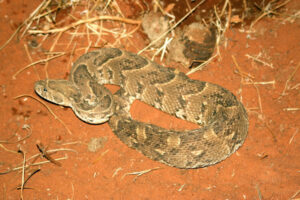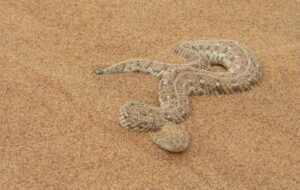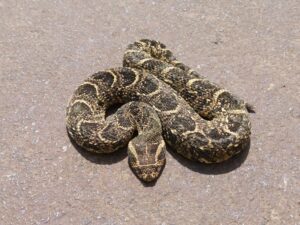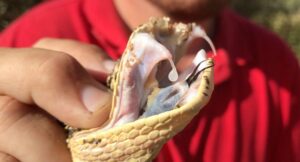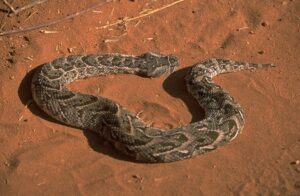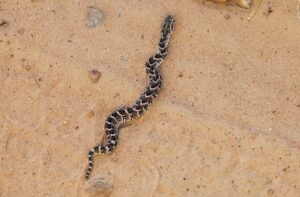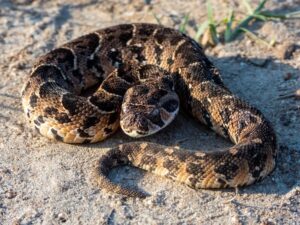The puff adder is a venomous snake primarily found in Africa. It is the most widespread snake on the continent. Also known as African Puff Adder and Common Puff Adder, it was described by German naturalist Blasius Merrem in 1820. The word arietans comes from the Latin arieto, meaning “striking violently.” They got their name from how they inflate themselves to appear larger than they are and hiss when threatened. They have several names in Swahili, like Bafe, Lipili, Moma, and Kifutu.
They are very aggressive and can attack with little warning. These solitary snakes are fatal to humans, and their bite can cause death within 25 hours. Because of their wide distribution, aggressive nature, and proximity to humans, they cause more deaths in Africa than any other snake.
The puff adders are not the best option to be kept as pets because of their bad temper. They hiss and puff when approached, and some never settle down in captivity. They can live on a meal per week for years, but they eat anything given to them, which often leads to their death. Despite such difficulties, some people do keep them as pets.
Scientific Classifications
- Suborder:Serpentes
- Family:Viperidae
- Genus:Bitis
- Species:B. arietans
Conservation Status
Subspecies and Morphs
Puff adders have two subspecies:
- African Puff Adder (Bitis arietans arietans)
- Somali Puff Adder (Bitis arietans somalica)
Description
Size:
The total length of this snake is between 39–75 inches (100–190 cm). Usually, males are longer than females. Males have longer tails, whereas females have short, stubby tails. Larger specimens weighing around 13.2 lbs (6 kg) have a width of 16 inches (40 cm).
Color and Appearance:
The body color of the puff adder varies based on its location. It can be light brown, straw yellow, orange, or reddish brown. Their body is covered with a pattern of 18-22 dark brown to black bands that are backwardly directed.
They have two prominent dark bands on their heads, one between the eyes and another on the crown. The rest of its head is yellowish-white with scattered dark blotches.
The shape of the bands varies as per their location. Mostly it is chevron-shaped, but in some areas, it is U-shaped. Some individuals are heavily flecked with brown and black, overshadowing other colors. This gives the snake a blackish or dusty-brown appearance.
Their head is somewhat triangular-shaped with a blunt, rounded snout. They have a small rostral scale and 10-16 scales in the circumorbital ring. There are 7-11 interocular scales across the top of the head. 3-4 scales separate the suboculars and supralabials. They have two functional fangs on each upper jaw that are almost two inches long. The midbody has 29-41 rows of dorsal scales, 123-147 ventral scales, and 14-38 subcaudals. The females can have a maximum of 24 subcaudals. The scales on the dorsal region are strongly keeled except for those on the outermost row, which gives them a rough appearance. They have a single anal scale.
Are They Dangerous to Humans
Puff adders are venomous and fatal to humans. They are responsible for the most deaths due to snakebites in Africa. They do not scurry away when they hear footsteps and give a warning through a soft hiss, which humans often miss out on or cannot hear. Instead, the snakes stay where they are and use their camouflage to remain hidden. This leads to more human encounters and snakebites.
They can yield cytotoxic venom of 150 – 350 mg. Just 100 mg of poison is sufficient to kill an adult human being. Their median lethal dose (LD50) in mice is 0.4–2.0 mg/kg intravenously, 0.9–3.7 mg/kg peritoneally, and 4.4–7.7 mg/kg subcutaneously. The bite victim’s death occurs after 25 hours. However, death has been reported in less than 15% of untreated cases.
The symptoms of its envenomation include edema, nausea, vomiting, hypertension, weakness and dizziness, subcutaneous bruising, painful swelling of the local lymph nodes, and blood blisters. If not properly treated, it spreads necrosis, causing skin, muscle, and subcutaneous tissue damage.
Puff Adder at a Glance
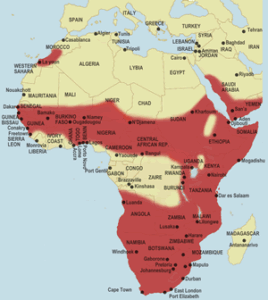
Distribution
These snakes are found in sub-Saharan Africa south of Cape of Good Hope, including southern Algeria, Angola, Botswana, Benin, Burundi, Chad, Cameroon, Central African Republic, Cote d’Ivoire, northern, southern and eastern Democratic Republic of Congo, Guinea, Ghana, Kenya, Morocco, Mauritania, Mali, Malawi, Mozambique, Namibia, Niger, Nigeria, Rwanda, Somalia, Sudan, Senegal, South Africa, Sierra Leone, Tanzania, Togo, Uganda, Zambia, and Zimbabwe. They also live in southwestern Saudi Arabia and Yemen on the Arabian Peninsula. A few of them also reside in the Dhofar region of southern Oman.
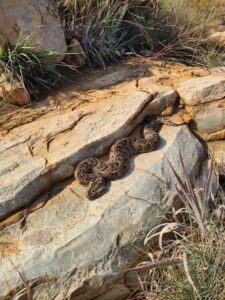
Habitat
Puff adders can live in any habitat except rainforests, alpine (tropical) habitats, and true deserts as long as they can access a permanent water source. Their preferred habitats are savannahs and rocky grasslands.
Lifespan
They live for 13 to 16 years in captivity. Their lifespan is shorter in the wild due to predation and food deficiency.
Predators
The potential predators of puff adders are eagles, warthogs, cobras, hornbills, and honey badgers.
They display olfactory crypsis, which makes it difficult for their predators to detect them through scent. This ability of theirs is hypothesized to be related to a low metabolic rate or moving to a different location after shedding their skin and defecating.
When disturbed, they form an S-shape with their body and adopt a defensive position. They move rectilinearly and, if threatened, can move with surprising speed. However, they usually are slow and reliant on camouflage to save themselves from predators. They are good swimmers and climbers.
Diet
These snakes are nocturnal carnivores. They prefer to ambush their prey and remain in a striking position, waiting for their prey for several days or weeks. Their diet includes mammals, amphibians, birds, lizards, and tortoises. The young ones eat insects, small rodents, and frogs.
They are among the fastest-striking snakes. The puff adder releases the prey after attacking to get ready to do so again. Adults can strike to a distance of one-third of their body length. In contrast, juveniles move their entire body forward while attacking.
Reproduction
Puff adders are promiscuous, with both males and females having multiple partners. To attract partners, females produce a pheromone, whereas males engage in neck-wrestling combat dances. They reach reproductive maturity at the age of 4 years. Their mating period is between October and December.
Courtship generally lasts an hour, starting when the male follows and flicks his tongue at the female. He then convulses and attempts to lift her tail until he can climb over her. The male will continue to writhe until his would-be mate rejects him or opens her cloaca. Intercourse takes place internally using one of the male’s hemipenes. Both partners undulate their tails during the entire encounter.
The gestation period is 136–159 days. These snakes are viviparous, and the mothers carry the eggs within themselves to protect them from predators. They can give birth between December and April to a litter of 50–60 hatchlings, with a maximum of 80 hatchlings. The newborns are 4.9-6.8 inches. The mother is not required to take care of the newborns. They become independent to take care of themselves after birth.
Similar Species
Red Adder
This viper is a venomous species found only in Western Cape Province, South Africa, whereas puff adders are found in many regions of Africa.
Horned Adder
Unlike puff adders, horned adders have a large horn-like scale over each eye.
Care Sheet
Size of Enclosure: These snakes do not need large enclosures because of their sluggish behavior. The size of their enclosure depends on their length. The small ones around 2.6 feet require a 3.2 x 1.6 x 1.6 feet terrarium, the ones of length 3.9 – 4.2 feet require a terrarium of 4.2 x 3.2 x 1.6 feet, and the larger ones who are 5 feet long need at least 5 x 3.2 x 1.5 feet terrarium. It is recommended not to keep more than one puff adder in a single terrarium.
Hiding Place: It is good to have a hiding spot in their terrarium that can help the snake to thermoregulate and feel safe. The hiding spot can be flowerpots, plastic caves, stapled stones, wood, or cork bark.
Substrate: Puff adders need a substrate of 0.15 – 0.3 feet in depth. Beach wood chippings or peat can be used as a substrate, which should be kept dry at all times.
Humidity: The room where the snake is kept should maintain a humidity level of 50 – 65%. During the final stage of the shedding cycle, the room should be sprayed every other day without making the substrate wet.
Temperature: The temperature at which puff adders are kept depends upon the region from which they are coming. Snakes born in the equatorial region prefer an ambient temperature of 28⁰C during the day and 20 – 22⁰C at night. Those from northern and southern zones should be kept at a lower ambient temperature of 23⁰C during the day for 2-3 months (winter period) and 15 – 16⁰ C at night.
Lighting: The lighting also depends on the region they belong to. Equatorial specimens should be kept at 12/12 hours lighting schedule throughout the year. In contrast, northern and southern snakes require 14/10 hours of light/dark in summer and vice versa in winter.
Diet/Feeding: These snakes are easy to feed. They eat live pinky mice. One should never overfeed them.
Source
projectnoah.org, theanimalfacts.com, turntable.kagiso.io, toxinology.com, reddit.com, content.eol.org,

